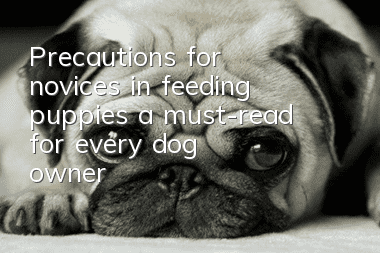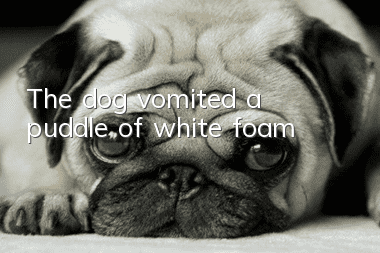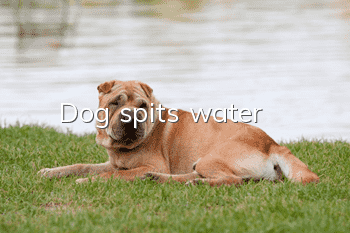Precautions for novices in feeding puppies, a must-read for every dog owner!

Many people start raising dogs unplanned, such as seeing a particularly cute dog on a whim, such as seeing a very pitiful dog, such as a friend suddenly giving you a dog, etc. etc. In short, you start raising a dog when you don’t understand how to raise a dog at all. Improper feeding may cause the dog to get sick or even die, especially puppies. Next, the editor will introduce to you in detail the precautions for feeding puppies for novices, a must-read for poop shovelers!
The precautions for feeding puppies:
1. How many meals does a puppy eat a day? How much does it eat?
The puppies we take home are usually after weaning, usually around two months. At this time, the puppies The intestines and stomach are not fully developed, so feeding must be nutritionally comprehensive and balanced, and easy to digest. It is best to eat small meals frequently, and it is recommended to feed four to five times a day. Feed special puppy dog food. The dog food can be soaked in warm water or goat's milk until soft. Dry dog food can be fed to dogs over three months old. The number of feedings can be reduced to two or three times after five to six months, and to two meals a day after ten months.
Many puppies do not feel full. They need to eat as much as they want. Overfeeding can cause intestinal damage to puppies, which may be serious or lead to death. Therefore, the amount of food fed to puppies is very important, and poop scrapers must learn to do so. Touch the puppy's belly and feed it so that its belly is not bloated after it is full. Also, don’t forget to provide your dog with plenty of clean water.
2. How to vaccinate? Can the puppy go out?
When the dog is first brought home, it needs to adapt to the new environment, and its resistance is weak at this time. , the vaccine cannot be injected immediately, because the vaccine is a weak virus, and the dog must have sufficient resistance to be properly immunized. It needs to be adapted to the dog at home for a week before the vaccine can be injected. (One more thing to note here is that if you take home a puppy that is just one month old, you need to wait until it is more than 50 days old before you can vaccinate it)
For vaccination, you must go to a regular pet hospital. Now Generally, the six-linked vaccine is chosen, both domestically produced and imported. You can choose according to your own economic situation. (The six-linked vaccine means the prevention of six acute infectious diseases in dogs, including: canine distemper, canine parvovirus, canine leptospirosis, infectious hepatitis, infectious bronchitis and parainfluenza disease)
There are 3 injections of the six-linked vaccine, one injection every 20 days. After the injection is completed, an antibody test can be done, because it is not ruled out that some dogs may not be immunized successfully. After that, one injection is enough every year.
Puppies need another shot of rabies vaccine after 3 months of age, and then once a year.
After vaccination, the dog’s immunity will be reduced. Therefore, during the vaccination period and within 7 days after the injection, it is not recommended to take the dog to play outdoors, bathe, etc. If the dog develops allergies, it needs to be sent to the doctor in time!
3. How long to give the dog dog bath oneTimes? How to wash?
If you don’t bathe for too long, it will also cause the dog’s hair to become tangled and hide dirt, which will lead to skin infection of the dog and damage the dog’s health.
It is recommended to take a bath once every two weeks, or once a week if you are particularly fond of cleanliness. It is not recommended to wash every day. If you wash too often, it will destroy the oil balance of the dog's skin and damage the dog's skin.
When bathing your dog, be sure to use dog-specific shower gel. Do not use human shower gel because the pH value of dogs is different from that of humans. When taking a bath, you should also pay attention to keeping warm and drying in time, especially dogs with thicker and longer hair. Failure to dry the hair will easily cause skin diseases.
4. What should I do if my dog urinates and poops randomly?
Puppies have not yet learned to control their bowels and bladder, so we need to be patient and don’t beat or scold them. Hitting and scolding can make dogs fear going to the toilet. As long as there is patient training and guidance, the dog can learn to defecate and urinate at fixed points, as fast as a week to half a month, or as slowly as a month.
Step 1: Prepare a dog toilet and place it where you want your dog to urinate and defecate. Also prepare a bottle of deodorant or disinfectant and some dog snacks
Step 2: Dogs usually just wake up and urinate about 10 minutes after eating or drinking. Take this time to put the dog on the toilet, encourage it to urinate in the toilet, and reward it with snacks immediately after peeing
Step 3: If you find your dog peeing elsewhere, immediately wipe off the urine with toilet paper or newspaper, let the dog smell the urine-stained paper, and put it in the dog toilet in front of it to guide it Pee in the toilet, and spray deodorant or disinfectant on the place where the dog has peed.
Step 4: Place the snacks in an easily accessible place near the toilet. As long as the dog is found to have peed, When you pee in the toilet, give a snack reward immediately
Repeat the above steps, and the reward should be timely, and the dog will learn it soon!
- Why do dogs eat their own children?
- What causes vomiting in puppies? Owners cannot take it lightly!
- How to train a dog? How to train dog behavior!
- What’s wrong with dogs’ loose stools?
- How many days does it take for a dog to have its ears erect after being taped?
- Can dogs take cold medicine?
- The dog vomited a yellow lump
- How is dog dermatitis treated?
- What's wrong with the blood on the dog's butt?
- What are the ways to prevent dogs from getting skin diseases in summer? Keep dogs away from skin diseases!



